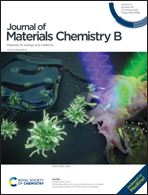Ultra-high photoactive thiadiazolo[3,4-g]quinoxaline nanoparticles with active-targeting capability for deep photodynamic therapy†
Abstract
Improving the effective treatment depth of photodynamic therapy (PDT) is an important issue to resolve for its clinical application. In this study, a new biocompatible photosensitizer (PS), namely TQs-PEG4, based on thiadiazolo[3,4-g]quinoxaline (TQ) with ultra-high photoactive property is designed and synthesized. TQs-PEG4 possesses an ultra-high singlet oxygen quantum yield (ΦΔ = 1.04). After encapsulating it with a biodegradable copolymer (DSPE–mPEG2000–cRGD), well distributed organic TQs-PEG4 nanoparticles (NPs) are formed with good water dispersity and excellent active tumor-targeting property. In vitro PDT experiments reveal that TQs-PEG4 NPs present excellent phototoxicities towards different cancer cell lines with an ultra-low dosage (<0.3 μg mL−1). TQs-PEG4 NP mediated PDT significantly inhibited tumor growth even when the tumor was covered with a 6 mm thick piece of pork tissue under 660 nm laser irradiation. Both the histological analysis and biochemical testing demonstrated the good biosafety of TQs-PEG4 NPs towards mice. This study not only develops an ultra-high photoactive organic PS, TQs-PEG4, but also proves the great potential of TQs-PEG4 NPs for application in deep PDT.
![Graphical abstract: Ultra-high photoactive thiadiazolo[3,4-g]quinoxaline nanoparticles with active-targeting capability for deep photodynamic therapy](/en/Image/Get?imageInfo.ImageType=GA&imageInfo.ImageIdentifier.ManuscriptID=D1TB01306H&imageInfo.ImageIdentifier.Year=2021)


 Please wait while we load your content...
Please wait while we load your content...